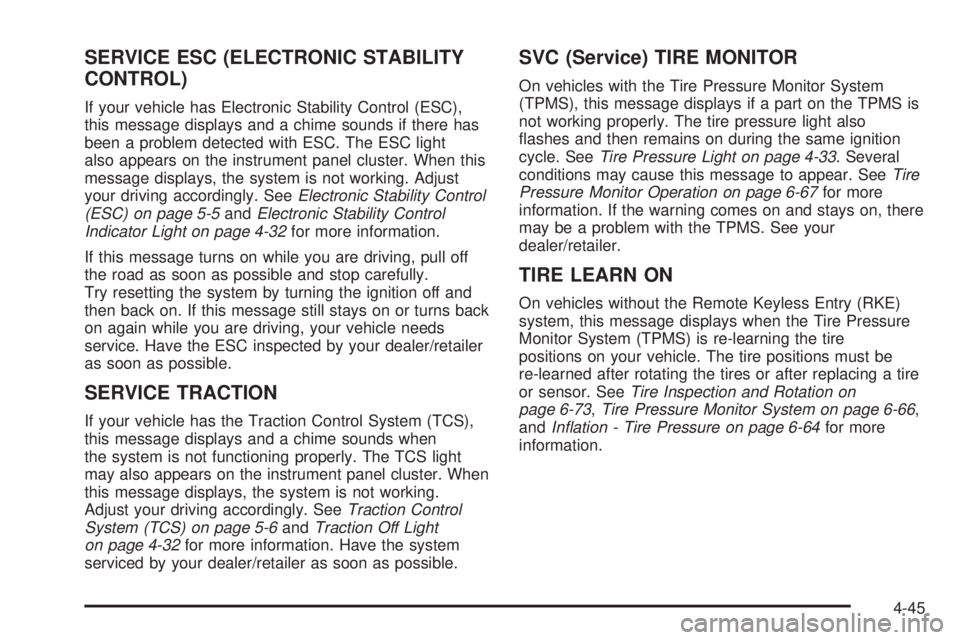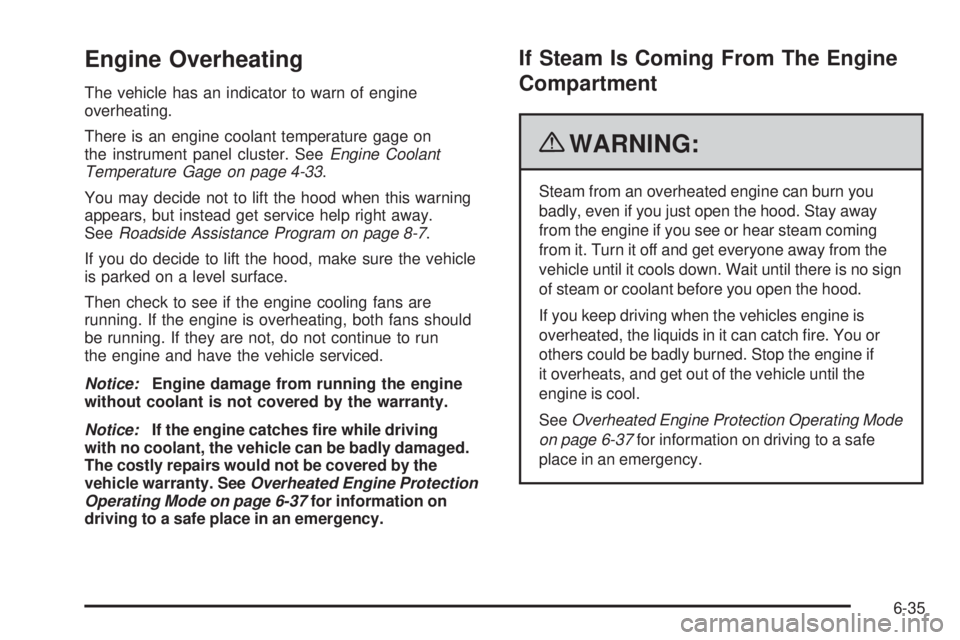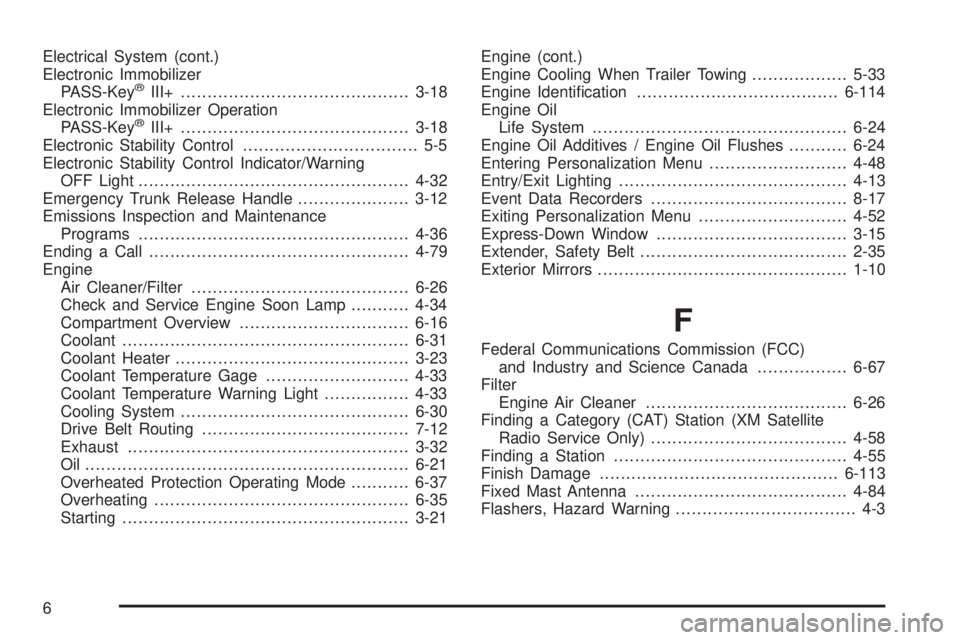service indicator PONTIAC G6 2010 User Guide
[x] Cancel search | Manufacturer: PONTIAC, Model Year: 2010, Model line: G6, Model: PONTIAC G6 2010Pages: 448, PDF Size: 2.5 MB
Page 187 of 448

Oil Pressure Light
{WARNING:
Do not keep driving if the oil pressure is low. The
engine can become so hot that it catches fire.
Someone could be burned. Check the oil as soon
as possible and have the vehicle serviced.
Notice:Lack of proper engine oil maintenance can
damage the engine. The repairs would not be
covered by the vehicle warranty. Always follow the
maintenance schedule in this manual for changing
engine oil.This light comes on briefly while starting the engine.
If it does not, have the vehicle serviced by your
dealer/retailer. If the system is working normally the
indicator light then goes off.
If the light comes on and stays on, it means that oil is
not flowing through the engine properly. The vehicle
could be low on oil and it might have some other system
problem.
Security Light
For information regarding
this light and the vehicle’s
security system, see
Content Theft-Deterrent on
page 3-16.
4-37
Page 193 of 448

CRUISE ENGAGED
This message displays when the cruise control system
is active. SeeCruise Control on page 4-7for more
information.
DOOR AJAR
This message displays if one or more of the vehicle’s
doors are not closed properly. Make sure that the
door(s) are closed completely.
ENGINE DISABLED
This message displays if the starting of the engine is
disabled. Have your vehicle serviced by your
dealer/retailer immediately.
ENG (Engine) PWR (Power) REDUCED
This message displays to inform you that the vehicle
has reduced engine power to avoid damaging the
engine. Reduced engine power can affect the vehicle’s
ability to accelerate. If this message is on, but there
is no reduction in performance, proceed to your
destination. The performance may be reduced the next
time the vehicle is driven. The vehicle may be driven
at a reduced speed while this message is on, but
acceleration and speed may be reduced. Anytime this
message stays on, the vehicle should be taken to
your dealer/retailer for service as soon as possible.
ESC (Electronic Stability Control) ACTIVE
If your vehicle has Electronic Stability Control (ESC),
this message displays and the ESC light on the
instrument panel cluster comes on when ESC is
assisting you with directional control of the vehicle. You
may feel or hear the system working and see this
message displayed in the DIC. Slippery road conditions
may exist when this message is displayed, so adjust
your driving accordingly. This message may stay on for
a few seconds after ESC stops assisting you with
directional control of the vehicle. This is normal when
the system is operating. SeeElectronic Stability Control
(ESC) on page 5-5andElectronic Stability Control
Indicator Light on page 4-32for more information.
ESC (Electronic Stability Control) OFF
If your vehicle has Electronic Stability Control (ESC),
this message displays and the ESC OFF light on
the instrument panel cluster comes on solid when ESC
is turned off. Adjust your driving accordingly. See
Electronic Stability Control (ESC) on page 5-5and
Electronic Stability Control Indicator Light on page 4-32
for more information.
ICE POSSIBLE
This message displays when the outside air temperature
is cold enough to create icy road conditions. Adjust
your driving accordingly.
4-43
Page 195 of 448

SERVICE ESC (ELECTRONIC STABILITY
CONTROL)
If your vehicle has Electronic Stability Control (ESC),
this message displays and a chime sounds if there has
been a problem detected with ESC. The ESC light
also appears on the instrument panel cluster. When this
message displays, the system is not working. Adjust
your driving accordingly. SeeElectronic Stability Control
(ESC) on page 5-5andElectronic Stability Control
Indicator Light on page 4-32for more information.
If this message turns on while you are driving, pull off
the road as soon as possible and stop carefully.
Try resetting the system by turning the ignition off and
then back on. If this message still stays on or turns back
on again while you are driving, your vehicle needs
service. Have the ESC inspected by your dealer/retailer
as soon as possible.
SERVICE TRACTION
If your vehicle has the Traction Control System (TCS),
this message displays and a chime sounds when
the system is not functioning properly. The TCS light
may also appears on the instrument panel cluster. When
this message displays, the system is not working.
Adjust your driving accordingly. SeeTraction Control
System (TCS) on page 5-6andTraction Off Light
on page 4-32for more information. Have the system
serviced by your dealer/retailer as soon as possible.
SVC (Service) TIRE MONITOR
On vehicles with the Tire Pressure Monitor System
(TPMS), this message displays if a part on the TPMS is
not working properly. The tire pressure light also
flashes and then remains on during the same ignition
cycle. SeeTire Pressure Light on page 4-33. Several
conditions may cause this message to appear. SeeTire
Pressure Monitor Operation on page 6-67for more
information. If the warning comes on and stays on, there
may be a problem with the TPMS. See your
dealer/retailer.
TIRE LEARN ON
On vehicles without the Remote Keyless Entry (RKE)
system, this message displays when the Tire Pressure
Monitor System (TPMS) is re-learning the tire
positions on your vehicle. The tire positions must be
re-learned after rotating the tires or after replacing a tire
or sensor. SeeTire Inspection and Rotation on
page 6-73,Tire Pressure Monitor System on page 6-66,
andIn�ation - Tire Pressure on page 6-64for more
information.
4-45
Page 275 of 448

Gasoline Octane
If the vehicle has the 2.4L L4 engine (VIN Code B),
the 2.4L L4 engine (VIN Code 0), the 3.5L V6 engine
(VIN Code K), the 3.5L V6 engine (VIN Code N), or the
3.9L V6 engine (VIN Code 1), use regular unleaded
gasoline with a posted octane rating of 87 or higher.
If the octane rating is less than 87, you might notice
an audible knocking noise when you drive, commonly
referred to as spark knock. If this occurs, use a gasoline
rated at 87 octane or higher as soon as possible. If you
are using gasoline rated at 87 octane or higher and you
hear heavy knocking, the engine needs service.
If the vehicle has the 3.6L V6 engine (VIN Code 7),
use regular unleaded gasoline with a posted octane
rating of 87 or higher. For best performance or trailer
towing, you could choose to use middle grade 89 octane
unleaded gasoline. If the octane rating is less than 87,
you might notice an audible knocking noise when you
drive, commonly referred to as spark knock. If this occurs,
use a gasoline rated at 87 octane or higher as soon as
possible. If you are using gasoline rated at 87 octane or
higher and you hear heavy knocking, the engine needs
service.
Gasoline Speci�cations
At a minimum, gasoline should meet ASTM specification
D 4814 in the United States or CAN/CGSB-3.5 or 3.511 in
Canada. Some gasolines contain an octane-enhancing
additive called methylcyclopentadienyl manganese
tricarbonyl (MMT). We recommend against the use of
gasolines containing MMT. SeeAdditives on page 6-8
for additional information.
California Fuel
If the vehicle is certified to meet California Emissions
Standards, it is designed to operate on fuels that meet
California specifications. See the underhood emission
control label. If this fuel is not available in states adopting
California emissions standards, the vehicle will operate
satisfactorily on fuels meeting federal specifications, but
emission control system performance might be affected.
The malfunction indicator lamp could turn on and the
vehicle might fail a smog-check test. SeeMalfunction
Indicator Lamp on page 4-34. If this occurs, return to your
authorized dealer/retailer for diagnosis. If it is determined
that the condition is caused by the type of fuel used,
repairs might not be covered by the vehicle warranty.
6-7
Page 276 of 448

Additives
To provide cleaner air, all gasolines in the United States
are now required to contain additives that help prevent
engine and fuel system deposits from forming, allowing
the emission control system to work properly. In most
cases, you should not have to add anything to the fuel.
However, some gasolines contain only the minimum
amount of additive required to meet U.S. Environmental
Protection Agency regulations. To help keep fuel injectors
and intake valves clean, or if the vehicle experiences
problems due to dirty injectors or valves, look for gasoline
that is advertised as TOP TIER Detergent Gasoline.
For customers who do not use TOP TIER Detergent
Gasoline regularly, one bottle of GM Fuel System
Treatment PLUS, added to the fuel tank at every engine
oil change, can help clean deposits from fuel injectors
and intake valves. GM Fuel System Treatment PLUS
is the only gasoline additive recommended by General
Motors.
Also, your dealer/retailer has additives that will help
correct and prevent most deposit-related problems.Gasolines containing oxygenates, such as ethers and
ethanol, and reformulated gasolines might be available in
your area. We recommend that you use these gasolines,
if they comply with the specifications described earlier.
However, E85 (85% ethanol) and other fuels containing
more than 10% ethanol must not be used in vehicles that
were not designed for those fuels.
Notice:This vehicle was not designed for fuel
that contains methanol. Do not use fuel containing
methanol. It can corrode metal parts in the fuel
system and also damage plastic and rubber parts.
That damage would not be covered under the vehicle
warranty.
Some gasolines that are not reformulated for low
emissions can contain an octane-enhancing additive
called methylcyclopentadienyl manganese tricarbonyl
(MMT); ask the attendant where you buy gasoline
whether the fuel contains MMT. We recommend
against the use of such gasolines. Fuels containing
MMT can reduce the life of spark plugs and the
performance of the emission control system could be
affected. The malfunction indicator lamp might turn on.
If this occurs, return to your dealer/retailer for service.
6-8
Page 277 of 448

Fuel E85 (85% Ethanol)
The 8th digit of the Vehicle Identification Number (VIN)
shows the code letter or number that identifies the
vehicle’s engine. The VIN is at the top left of the
instrument panel. SeeVehicle Identi�cation Number
(VIN) on page 6-114.
If the vehicle has the 2.4L L4 engine (VIN Code 0) or
the 3.5L V6 engine (VIN Code K), you can use either
unleaded gasoline or ethanol fuel containing up to
85% ethanol (E85). SeeFuel on page 6-6. In all other
engines, use only the unleaded gasoline described
underGasoline Octane on page 6-7.
Only vehicles that have the 2.4L L4 engine (VIN Code 0)
or the 3.5L V6 engine (VIN Code K) can use 85% ethanol
fuel (E85). We encourage the use of E85 in vehicles
that are designed to use it. The ethanol in E85 is a
“renewable” fuel, meaning it is made from renewable
sources such as corn and other crops.Many service stations will not have an 85% ethanol
fuel (E85) pump available. The U.S. Department
of Energy has an alternative fuels website
(www.eere.energy.gov/afdc/infrastructure/locator.html)
that can help you find E85 fuel. Those stations that
do have E85 should have a label indicating ethanol
content. Do not use the fuel if the ethanol content
is greater than 85%.
At a minimum, E85 should meet ASTM Specification
D 5798. By definition, this means that fuel labeled E85
will have an ethanol content between 70% and 85%.
Filling the fuel tank with fuel mixtures that do not meet
ASTM specifications can affect driveability and could
cause the malfunction indicator lamp to come on.
6-9
Page 303 of 448

Engine Overheating
The vehicle has an indicator to warn of engine
overheating.
There is an engine coolant temperature gage on
the instrument panel cluster. SeeEngine Coolant
Temperature Gage on page 4-33.
You may decide not to lift the hood when this warning
appears, but instead get service help right away.
SeeRoadside Assistance Program on page 8-7.
If you do decide to lift the hood, make sure the vehicle
is parked on a level surface.
Then check to see if the engine cooling fans are
running. If the engine is overheating, both fans should
be running. If they are not, do not continue to run
the engine and have the vehicle serviced.
Notice:Engine damage from running the engine
without coolant is not covered by the warranty.
Notice:If the engine catches �re while driving
with no coolant, the vehicle can be badly damaged.
The costly repairs would not be covered by the
vehicle warranty. SeeOverheated Engine Protection
Operating Mode on page 6-37for information on
driving to a safe place in an emergency.
If Steam Is Coming From The Engine
Compartment
{WARNING:
Steam from an overheated engine can burn you
badly, even if you just open the hood. Stay away
from the engine if you see or hear steam coming
from it. Turn it off and get everyone away from the
vehicle until it cools down. Wait until there is no sign
of steam or coolant before you open the hood.
If you keep driving when the vehicles engine is
overheated, the liquids in it can catch fire. You or
others could be badly burned. Stop the engine if
it overheats, and get out of the vehicle until the
engine is cool.
SeeOverheated Engine Protection Operating Mode
on page 6-37for information on driving to a safe
place in an emergency.
6-35
Page 309 of 448

Brake Wear
This vehicle has disc brakes. Disc brake pads have
built-in wear indicators that make a high-pitched warning
sound when the brake pads are worn and new pads
are needed. The sound can come and go or be heard
all the time the vehicle is moving, except when applying
the brake pedal firmly.
{WARNING:
The brake wear warning sound means that soon
the brakes will not work well. That could lead to an
accident. When the brake wear warning sound is
heard, have the vehicle serviced.
Notice:Continuing to drive with worn-out brake
pads could result in costly brake repair.
Some driving conditions or climates can cause a brake
squeal when the brakes are first applied or lightly applied.
This does not mean something is wrong with the brakes.
Properly torqued wheel nuts are necessary to help
prevent brake pulsation. When tires are rotated, inspect
brake pads for wear and evenly tighten wheel nuts in the
proper sequence to torque specifications inCapacities
and Speci�cations on page 6-125.Brake linings should always be replaced as complete
axle sets.
Brake Pedal Travel
See your dealer/retailer if the brake pedal does not
return to normal height, or if there is a rapid increase
in pedal travel. This could be a sign that brake service
might be required.
Brake Adjustment
Every time the brakes are applied, with or without the
vehicle moving, the brakes adjust for wear.
Replacing Brake System Parts
The braking system on a vehicle is complex. Its many
parts have to be of top quality and work well together if
the vehicle is to have really good braking. The vehicle
was designed and tested with top-quality brake parts.
When parts of the braking system are replaced — for
example, when the brake linings wear down and new
ones are installed — be sure to get new approved
replacement parts. If this is not done, the brakes might
not work properly. For example, if someone puts in
brake linings that are wrong for the vehicle, the balance
between the front and rear brakes can change — for the
worse. The braking performance expected can change in
many other ways if the wrong replacement brake parts
are installed.
6-41
Page 431 of 448

A
Accessories and Modifications............................ 6-4
Accessory Power............................................3-21
Accessory Power Outlets.................................4-15
Adding Washer Fluid.......................................6-38
Additional Factors Affecting System Operation.....2-71
Additional Program Information.........................8-11
Additional Required Services.............................. 7-4
Additives, Fuel................................................. 6-8
Add-On Electrical Equipment...........................6-115
Adjusting the Speakers (Balance/Fade)..............4-58
Air Cleaner/Filter, Engine.................................6-26
Air Conditioning..............................................4-16
Airbag
Adding Equipment to Your Airbag-Equipped
Vehicle...................................................2-72
Airbag System
How Does an Airbag Restrain?......................2-65
Passenger Sensing System...........................2-67
Servicing Your Airbag-Equipped Vehicle..........2-72
What Makes an Airbag Inflate?......................2-65
What Will You See After an Airbag Inflates?....2-65
When Should an Airbag Inflate?....................2-63
Where Are the Airbags?...............................2-61
Airbags.........................................................2-74
Passenger Status Indicator...........................4-29
Readiness Light..........................................4-28
System Check.............................................2-59AM ...............................................................4-83
Antenna
Backglass...................................................4-84
Fixed Mast.................................................4-84
Antenna, XM™ Satellite Radio Antenna
System......................................................4-84
Antilock Brake System (ABS)............................. 5-4
Warning Light.............................................4-31
Appearance Care
Aluminum Wheels......................................6-112
Care of Safety Belts...................................6-110
Chemical Paint Spotting..............................6-114
Cleaning Exterior Lamps/Lenses
..................6-111
Fabric/Carpet............................................6-108
Finish Care...............................................6-111
Finish Damage..........................................6-113
Instrument Panel, Vinyl, and Other Plastic
Surfaces...............................................6-109
Interior Cleaning........................................6-107
Leather....................................................6-109
Sheet Metal Damage..................................6-113
Tires........................................................6-113
Underbody Maintenance.............................6-113
Washing Your Vehicle.................................6-110
Weatherstrips............................................6-110
Windshield and Wiper Blades......................6-112
Arming the System.........................................3-16
Assistance Program, Roadside........................... 8-7
1
Page 436 of 448

Electrical System (cont.)
Electronic Immobilizer
PASS-Key
®III+...........................................3-18
Electronic Immobilizer Operation
PASS-Key
®III+...........................................3-18
Electronic Stability Control................................. 5-5
Electronic Stability Control Indicator/Warning
OFF Light...................................................4-32
Emergency Trunk Release Handle.....................3-12
Emissions Inspection and Maintenance
Programs...................................................4-36
Ending a Call.................................................4-79
Engine
Air Cleaner/Filter.........................................6-26
Check and Service Engine Soon Lamp...........4-34
Compartment Overview................................6-16
Coolant......................................................6-31
Coolant Heater............................................3-23
Coolant Temperature Gage...........................4-33
Coolant Temperature Warning Light................4-33
Cooling System...........................................6-30
Drive Belt Routing.......................................7-12
Exhaust.....................................................3-32
Oil .............................................................6-21
Overheated Protection Operating Mode...........6-37
Overheating................................................6-35
Starting......................................................3-21Engine (cont.)
Engine Cooling When Trailer Towing..................5-33
Engine Identification......................................6-114
Engine Oil
Life System................................................6-24
Engine Oil Additives / Engine Oil Flushes...........6-24
Entering Personalization Menu..........................4-48
Entry/Exit Lighting...........................................4-13
Event Data Recorders.....................................8-17
Exiting Personalization Menu............................4-52
Express-Down Window....................................3-15
Extender, Safety Belt.......................................2-35
Exterior Mirrors...............................................1-10
F
Federal Communications Commission (FCC)
and Industry and Science Canada.................6-67
Filter
Engine Air Cleaner......................................6-26
Finding a Category (CAT) Station (XM Satellite
Radio Service Only).....................................4-58
Finding a Station............................................4-55
Finish Damage.............................................6-113
Fixed Mast Antenna........................................4-84
Flashers, Hazard Warning.................................. 4-3
6